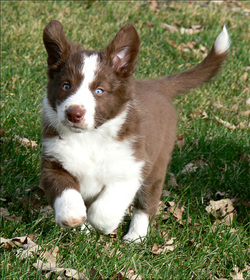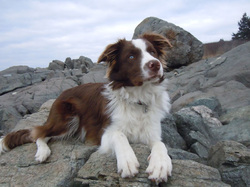
Recently I was told about a friend who has a 5 month old Border Collie who used a shock collar on her puppy to keep her quite at a seminar. The story gets worse when I actually witnessed a class this past weekend with the local “shock collar guru” training a class of 10-12 dogs with shock collar controls in hand. I was at an agility show and in an adjoining field, the class was in session. The dogs were being taught to lay down, let the owner walk to the end of a leash and come when called. This all seemed to be part of a typical beginner or puppy class until I saw that each of the class participants had a shock collar control in their hand….. For what…. to shock the dog if they did not come when called?
Research on the Use of Shock Collars in Dog Training
Jennifer Cattet Ph.D. has been working with dogs for almost 30 years, as an ethologist with the University of Geneva (Switzerland), a trainer and a behaviorist (in both Europe and the US). She writes in her article, “New Findings on Shock Collars and Why the UK Wants to Ban Them,” http://blog.smartanimaltraining.com/2013/07/31/new-findings-on-shock-collars-why-the-uk-wants-to-ban-them/
“In the dog world, few subjects are as controversial as the debate on shock collars (electronic or e-collars). Advocates for their use claim that such devices don’t hurt but mostly emit an unpleasant vibration. They’re often the last resort for dogs with behavior drives that are difficult to control, like recall or chasing problems. Opponents to their use believe they can be harmful to dogs and should not be available to the public.”
A number of studies have been done on the short and long effects of shock collars. This study done by researchers in the Netherlands with 32 dogs in the shock collar (S-dogs) compared with the same number of dogs in the control no shock collar group (C-Dogs) investigated the effects of shock collars when used in a training field, for obedience training, for protection work and free walk.
http://blog.smartanimaltraining.com/2013/07/31/new-findings-on-shock-collars-why-the-uk-wants-to-ban-them/
The Effects of Shock-Collar Corrections on Body Posture
The study found that in the 32 dogs that received a total of 107 shocks, there was an immediate direct effect in which the dogs most commonly:
· Lowered their of body posture (22 of 32 dogs)
· Gave high-pitched yelps (17 of 32 dogs)
· Gave tongue flicks (18 of 32 dogs)
· Lowered their tail (13 of 32 dogs)
· Squealed (13 of 32 dogs)
· Turned their head down and to the side to avoid the shock (7 of 32 dogs)
· Moved away (avoidance) (14 of 32 dogs)
· Gave a barking scream (5 of 32 dogs)
· Crouched (6 of 32 dogs)
Dogs also lifted their front paw, lowered their back, jumped, licked their lips, circled, trembled, and sniffed the ground. All of the listed behavioral responses are signs of fear, pain, or anxiety and stress. Seven dogs showed no reaction.
From a Top Dog Trainer’s Life Long Journey to Understand Reinforcement
Susan Garrett who for me is one of the top dog trainers in the world and only uses positive methods, often talks about the effects of positive and negative reinforcement. She has dedicated her life long journey to better understand the use of reinforcement in dog training. Read what Susan has to say about negative reinforcement in her earlier blog entries:
http://susangarrettdogagility.com/2010/04/there-is-a-better-way-find-it/
http://susangarrettdogagility.com/2010/04/punishment-pros-and-cons/
My Journey with Recent Dog Challenges
My young Border Collie was over the top excited and barking when she would watch other dogs running, coming into our training field, doing agility at shows or seminars and especially at agility shows. Susan Garrett has helped me better understand how to deal with challenges our dogs present us with. One effective way I have found that has worked for me in the above situation is to manage my dog.
· While I am training my other Border Collie, Myst is in her crate COVERED in the car.
· At shows we are back from the ring in the second aisle. Her crate might be covered depending on the visual stimulation. However seldom do I need to cover her crate now… she is 3 years old.
· At seminars we were away from the area where dogs were working where she could see and perhaps even not hear the working dog. However recently Myst is able to lie by my side while other dogs are working in a class or seminar. She is quite and calmer lying with me where I can talk to her and reinforce her calm then having her in her crate.
· At home Myst is rewarded for sitting quietly when over stimulated. Certain activities, such as in the bathroom like starting a hair blower, can put her over the top with excited barking. She now sits quietly looking at me for her calm reward when those activities that put her into bark mode occur. AND yes, a treat for sitting patiently for the entire duration of that stimulating behavior.
· We have a raised dog bed in our home training room. The Border Collies take turns working and then sitting quietly while the other dog works. The quite waiting dog gets rewarded for their calm patience. This is relatively new; last year I don’t think my young BC could have handled it…but with maturity new opportunities for calm, patience, and no barking are introduced.
· No barking is allowed in the obedience ring or when doing obedience training unless we are toy playing to build motivation and happiness. If barking occurs, all work stops. I freeze and may turn away from Myst if she barks. No rewards until the performance is done quietly… then JACKPOT with many high value treats.
- Example: Refocusing on how to train Utility GO OUTS in obedience. The GO OUTS in Utility are one of the most difficult obedience exercises to train... and there are many ways to train them. Initially I trained Myst to go out to a small cap with a treat. However, if she did not mark straight she might begin sniffing which is not what I wanted. I then went to the GO HIT the stantion at the end of the ring method. This put her over the top of the arousal curve. She would bark with excitement when I told her the exercise, or when running out to do her HIT and when she heard me working with my other Border Collie on this exercise. She was not responding to my stop working, freeze and only reward for calm, quiet GO OUTS.... there was no such thing as a quiet GO OUT.. My choices were to use some negative to stop her or try to convince her to not bark or squeal. I decided to go back to my earlier method of using the cap which she did quietly. We would take steps backward to shape this behavior and help her learn to mark her path. It might take longer but it did not extinguish her joy for this exercise with a negative. This worked... not only did she understand this but also and most importantly NO barking.
I am happy to report that we have no barking in the ring when training or performing obedience. All toy play is done outside the ring where she is allowed to verbally express her joy or happiness.
I have to admit we still have many challenges… especially with agility barking. My young Border Collie barks frequently in agility not only with the joy of doing agility but also when she is frustrated with a new training exercises or when I do not give her timely commands.
She occasionally barks when we are hiking in slower areas or snowshoeing when she thinks I am not going fast enough…. Myst seems to feel the need to take care of me and check on me often when we are out hiking. When other dogs or friends are hiking with us, no need to care for Mom… no barking. This I work on. One must choose their battles and for now I continue to build on our positive reinforcement for calm, quiet behavior and am so happy to report that I have never once considered or have used an e-collar for our training… And as you will see in my videos I have 2 very very happy Border Collies.
Happy Dogs
Today I just posted a new video using my new GoPro Hero 3. Catherine Rios from FitPaws posted this on their Facebook page.
"Cynde Leshin with www.2coolbcs.com has made my day!! Her dogs show off some really unique exercise combinations with their FitPAWS equipment. Big smiles ear to ear, Thank you Cynde for bringing me so much joy this morning with this video. I love it! Check out these AMAZING Dogs! Happy Happy Happy Dogs!"
When you have a happy dog who have been trained with joy for learning and interacting with us, others can clearly see the smiles in their work.

 RSS Feed
RSS Feed